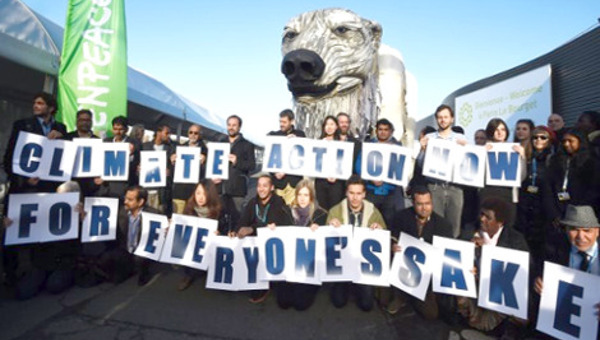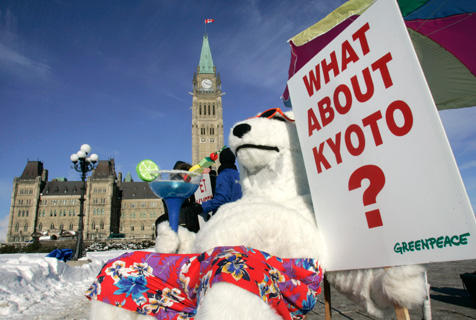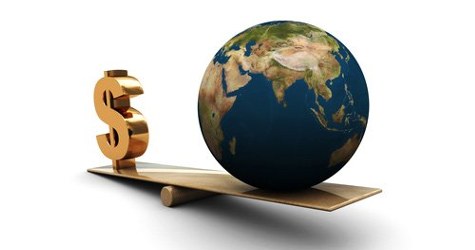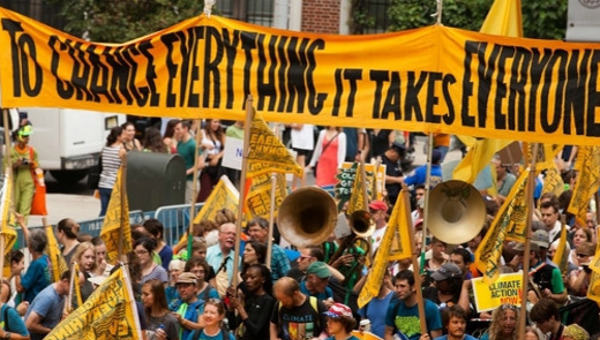The climate negotiations entered their final day, and we geared up for our most audacious action. Several buses brought four hundred activists to different locations near the conference hall. Adrenaline running, we walked fast toward the gates and the guards. After a week of discussing sea level rise, eating vegan food, blocking car traffic, and marching in the streets dressed as polar bears and turtles, we were out to make a real difference. Chaining our bodies to the gates and each other, we tried to prevent the negotiators from leaving the hall until they had come up with a proper agreement, all the while chanting: “No more bla bla bla – action now!”
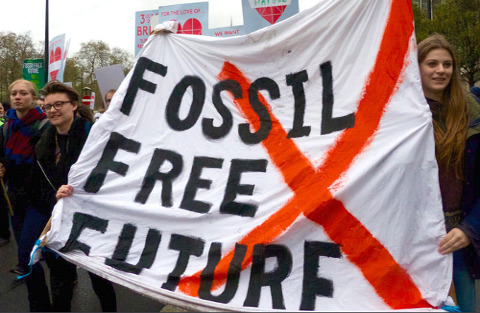 That was twenty years ago, at the very first United Nations Climate Change Conference (COP), in Berlin. The negotiators, needless to say, snuck out the backdoors. Since then, a tidal wave of bureaucratic logorrhea has rolled over the planet every December, as the COPs have degenerated into annual exhibits in the latest innovations in officialese. No tangible measures other than the construction of various vacuous carbon markets have materialized; CO2 emissions from fossil fuels have not declined, not leveled off, not increased a little more slowly, but soared by 50 per cent under the cover of two decades of ever more bla bla bla.
That was twenty years ago, at the very first United Nations Climate Change Conference (COP), in Berlin. The negotiators, needless to say, snuck out the backdoors. Since then, a tidal wave of bureaucratic logorrhea has rolled over the planet every December, as the COPs have degenerated into annual exhibits in the latest innovations in officialese. No tangible measures other than the construction of various vacuous carbon markets have materialized; CO2 emissions from fossil fuels have not declined, not leveled off, not increased a little more slowly, but soared by 50 per cent under the cover of two decades of ever more bla bla bla.
And now the demonstrations at COP21 in Paris have been banned. This decision by the French state was not an anomaly, brought about by the November 13 massacre. Repression has intensified at every summit since the fateful COP15 in Copenhagen.
Banning Protests
That December, six years ago, activists officially registered as visitors prowled the corridors of the Bella Center for opportunities to intervene in the proceedings, while ever-bolder plans were hatched from the outside. As the negotiations entered their downward spiral, protests erupted spontaneously inside the center and wound their way through the Danish capital. Militants prepared to overrun the summit and turn it into a “people’s assembly.”
Under siege, authorities responded with force. Registration cards were withdrawn, insufficiently pliant NGOs banished, and lines of baton-wielding policemen stationed at the entrances. At each subsequent COP, the hosts have made sure to keep the venues sealed off from the climate movement – denying activists access, banning participants in on-site protests from future conferences, patrolling the surroundings with armed police and soldiers, all measures meant to keep out the most radical voices from the proceedings. It was in this spirit that the French state did its best to thwart the planned COP21 mobilizations long before the terror attacks.
Initially, the government refused to give the organizers of the now-prohibited demonstration a route. The process of applying for French visa suddenly became more arduous in countries of the South; in spite of assurances to the contrary, spaces for accommodating the tens of thousands of expected activists were not arranged. The atrocities were then used as a pretext to completely insulate COP21.
Few expected any concrete action to emerge from it, but Paris would have seen the greatest show of strength from the climate movement so far: some things, after all, have changed since that first conference in 1995. At that time, climate change – or the “greenhouse effect,” as it was more often called – was a cause of concern somewhere between the ozone layer and acid rain for an environmental movement often still hopelessly isolated from mainstream opinion. Only a few hundred of us showed up in Berlin for a reason.
Although it is not nearly as large or powerful as it needs to be, the climate movement today is a force to be reckoned with, a sprawling tent of groups capable of scoring such victories as pushing Shell out of the Arctic and killing the Keystone XL pipeline. It is that force that has now been taken off the streets of Paris.
Why? Security concerns in the wake of the terror are at most secondary. If the French state wanted to safeguard the demonstrations – thereby guaranteeing the type of freedom for which it claims to be waging war – it could have offered reinforced protection or even searched participants at assembly points (a commonplace in countries truly plagued by terror).
As Naomi Klein has pointed out, the French state of emergency applies blatant double standards: the Christmas market at Champs Elysées – masses thronging the avenue to do their shopping – retains a green light, as do soccer matches, even though one was an actual target on November 13. The government’s priorities are evident.
Over the past year, the French state has invested all its diplomatic power in ensuring a successful COP21. Avoiding another debacle á la Copenhagen has become a point d’honneur for President François Hollande, the signing of a fresh agreement a pursuit that must not in any way be disrupted. No one can be allowed to trash this historical party.
Copenhagen Accord: Coup d’Êtat
So what is it the French state and its allies in this warming world want to achieve in Paris?
Copenhagen – as David Cipitle, J. Timmons Roberts, and Mizan R. Khan’s Power in a Warming World demonstrates – truly was a turning point in the struggle over the fate of the planet. Up till then, the UN climate negotiations had always aimed at an agreement with binding commitments: countries would set a common target and then be legally obliged to reduce their emissions. Even the Kyoto Protocol, for all its uselessness, enshrined the principle.
At the eleventh hour of COP15, however, the United States won over the leaders of Brazil, South Africa, India, and China to the opposite approach: countries would henceforth set their own targets and then freely decide whether to actually reduce their emissions. In a veritable coup d’êtat, under the leadership of Barack Obama, the five nations secretly developed a Copenhagen Accord along those lines and presented it to the rest of the world as a fait accompli.
Yet resistance among the countries of the South – represented by such combative spokesmen as Sudan’s Lumumba Di-Aping and Bolivia’s Pablo Solón, and bolstered by the pressure of the movement – was still strong enough to withstand the plot. The Copenhagen Accord was not signed, only “taken note of” by the final plenary.
It took another year of systematic American arm-twisting to sway the South. After terminations of aid programs and threats thereof, promises of money for adaptation, sowing of division among the developing countries, and a set of other manipulative tactics – all masterfully tracked Power in a Warming World – every country save for Bolivia gave in to the American plan at COP16.
Since then, with the resistance crushed, the voluntary framework has ruled the day. Paris is meant to consecrate it. In the long run-up to COP21, countries have submitted their INDCs, the currently dominant species in the ever-growing jungle of off-putting acronyms, standing for “Intended Nationally Determined Contributions.” Nation after nation has stepped forth and said: we intend to cut our emissions – or let them grow, or tweak them – by this and that amount until this or that year. The pledges are then fed into a pool of cuts, whose sum is supposed to meet the needs of all humanity. It’s a process without coordination – “bottom-up,” flexible, and dynamic in the eyes of the proponents. It could also be viewed as a free-for-all of the remaining space to burn fossil fuels before everything burns.
Flawed ‘Solution’
The INDC system has, as even the most mainstream of observers have noted, three obvious flaws.
First, the numbers don’t add up. The generally agreed upon target of keeping global warming at no more than 2 degrees Celsius is clearly too lax: we have witnessed a mere 0.9 so far – from which poor people across the world are already reeling – and the process is known to be non-linear, so one can only imagine how rough and inhospitable a world of 2 degrees would be. But it can still serve as an approximate boundary between the dangerous and the extremely dangerous.
Now if all submitted INDCs are added up, and if the pledged emissions reductions actually do take place, the world is on course to heat up by somewhere above 3 degrees. (Given that the process may become self-impelling through various feedback loops, that could actually mean quite a lot more.)
One recent study found that even if the U.S., European Union, and China were to live up to their stated Paris promises, they would still burn so much that the rest of the world would have almost no space to emit if the 2 degrees is to hold. Everything suggests that the sum total of COP21 will have no relation whatsoever to the demands of science, not to mention the needs of people without property on the peripheries of the world system. It will condemn us to extreme, unprecedented, incalculable danger.
Second, the very idea of a voluntary framework is a sham. It has been argued that if commitments are non-binding and free, countries are likely to sign up for more. That is a bit like saying that if the spouses agree on their freedom to sleep with anyone, they are more likely to stay faithful – or if bankers can choose whether to pay taxes or not, more of them will.
The EU, the World Trade Organization, the International Monetary Fund, the whole global architecture of neoliberal institutions is replete with mechanisms for punishing countries that fail to honor their obligations, but on this particular issue – averting cataclysmic breakdown of the biosphere as we know it – there shall be freedom.
At the most, COP21 might oblige countries to review and renew their INDCs in the next few years and decades – but not to implement them. Some believe that doing so will become – how shall we put it – a point d’honneur. Others would counsel against counting on the honor and rationality of hitherto incorrigible pyromaniacs.
Third, the pre-Copenhagen consensus around a binding agreement as the endpoint of negotiations also retained the notion of fairness. In those years, all sorts of schemes were mooted for dividing the remaining allowable emissions in accordance with the principle that no human is born with a greater right to the atmosphere than any other. Hence the idea that the richest countries should slash their emissions and the poorest temporarily increase theirs, until they reached equally low per capita levels; or that obligations should be proportional to the historical responsibility for the problem; or that shares should be allocated on the basis of what countries were economically capable of. But under the INDCs, justice is jettisoned virtually by definition.
Each country simply says what it wants to do. So, for instance, if the U.S., EU, and China were to act as they claim they intend to, and if the 2 degree limit is to hold, by 2030 all other countries would have to keep their emissions on a per-capita level seven to fourteen times lower than for those three mega-emitters. In other words, the American, European, and Chinese leaders fly to Paris with the practical conviction that their citizens deserve a right to emit seven to fourteen times as much as those of Haiti, Laos, or Burundi. Since all is up for grabs, there can be no fair distribution.
And yet expect Hollande and his ministers to proclaim – on precisely these grounds – that a historic step toward solving climate change has been taken. The ruling classes need that kind of triumphal arch for their legitimacy. The purpose of COP21 is, for them, to produce the semblance of a solution, to instill the feeling that our leaders have finally promised to care for our common future and have stood up to the challenge of our time, and bla bla bla.
But the whole construction will, in the ever-dispassionate words of Ciplet et al., have “furthered the interests of a powerful investor class while largely failing to address our most pressing issues of environmental and social inequality” – put a veneer of good intentions on the brutal realities of business as usual. Fossil capital keeps profiting – others suffer the murderous consequences.
Global Class Struggle
The authors of Power in a Warming World conceive of the negotiations as a process of global class struggle. It is determined by the simple fact that “government representatives, who are structurally dependent on private sector profitability, may anticipate resistance from powerful business and related interests at home to initiatives that threaten established industries,” the unsaid mandate that ties negotiators to the status quo. It is particularly pernicious in countries where some of the greatest profits are made through fossil-fuel extraction. Hardly a coincidence, they point out, that the three countries with the largest proven reserves – the U.S., Russia, and China – have also been among the most consistently obstructionist.
On the other side, there are the countries whose very existence is at stake. Their weakness and vulnerability make them easy prey for the diplomatic machineries of the most advanced capitalist, heavily fossilized states. What from the outside may appear an impenetrable torrent of ciphers and figures and brackets is in fact a struggle over life and death between the representatives of capital and those who, at least to some extent, speak for people on the front lines of this warming world.
There have been moments when the COPs have been on the cusp of meaningful mitigation of climate change, and every time the rich bloc led by the United States has punctured them. There have been unending discussions on how to finance adaptation to climate change, and for every year the same bloc has excelled in diversion and manipulation: you poor countries want money to cope with the heat? We shall loan it to you through our private banks, at high interest rates! Any other money will be recycled from assistance budgets, or channeled through the World Bank, or not see the light of day at all – and you will have to fight for these crumbs among yourselves like wounded dogs.
Every COP consequently has its scenes of flaring anger and despair. For Paris, the nebulous backdoor bureaucracy has made sure to purge the negotiating teams of Di-Aping and Solón and similar fighters, making the balance of forces perhaps even more skewed than usual. Even in the absence of the bans, the opportunities for the climate movement to intervene might, some radical analyses suggest, have been fewer than ever.
But one should not discount the power of the survival instinct. In the preparatory talks in Bonn in October, South African negotiator Nozipho Mxakato-Diseko slammed the draft text for the Paris agreement as a recipe for “apartheid.” On behalf of the developing countries, she condemned it as “extremely unbalanced and lopsided,” guilty of having “disenfranchised” them as a human collective. Expect such embarrassments in Paris as well.
Even the government of South Africa – party to the COP15 coup – cannot fail to express some level of dismay at its people being sentenced to unlivable temperatures. Ciplet et al. note that people in the 48 least developed countries are currently five times more likely to die from climate-related disasters than the rest of humanity, while accounting for less than 1 per cent of CO2 emissions in history. In such a world, confrontation can never be far below the surface.
It remains incumbent on all activists who can make it to Paris, and all who prefer to march or act near home, to throw all their energy into that struggle. Alliances based on objective interests are still feasible: witness the proposal by Kiribati to impose a global moratorium on all new coal mines – or, in other words, to terminate the expansion of one of the most venerable and extensive industries in capitalism. This is the sort of head-on confrontation with fossil capital that constitutes our only hope. It should translate into mandatory reductions for the richest countries starting now, reaching at least 10 per cent a year by 2025, so that the world economy is completely free of fossil fuels well before mid-century. This may sound extreme, but such are the “revolutionary implications” of dry and dreary climate science.
Paris would have been the coming-of-age COP for a movement ready to make those demands. Now we have the state of emergency. Hollande and his peers crave silent streets. COP21 is their chance to bury the revolutionary implications of climate change, and untold numbers of people with them.
Ban or no ban, militant resistance in the streets has never been more imperative. They should not get away with this. •
This article first published on the Jacobin website.


